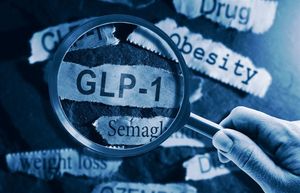– 39% of participants with low baseline Hepatitis B surface antigen (HBsAg) achieved HBsAg loss with tobevibart + elebsiran, and 46% with tobevibart + elebsiran + pegylated interferon alfa –
– No new safety concerns were identified, and treatment-emergent adverse events were generally mild to moderate –
– Late-breaking oral presentation of MARCH Part B study results at the American Association for the Study of Liver Diseases (AASLD) The Liver Meeting® –
– Key functional cure data from 24-week follow-up expected in Q2 2025 –
Vir Biotechnology, Inc. (Nasdaq: VIR) today announced end-of-treatment data from Part B of the MARCH Phase 2 clinical study evaluating combinations of tobevibart and elebsiran, with or without pegylated interferon alfa (PEG-IFNα), in participants with chronic hepatitis B. The study demonstrated promising rates of hepatitis B surface antigen (HBsAg) loss (seroclearance) in participants with low baseline HBsAg (<1000 IU/mL) in both combination regimens. The efficacy and safety profile support continued development to evaluate the potential to achieve a functional cure. Detailed data will be presented in a late-breaking oral presentation at the American Association for the Study of Liver Diseases (AASLD) The Liver Meeting®, in San Diego, CA, on November 18 at 5:00 p.m. PT. Vir Biotechnology will host an investor conference call on November 19, at 5.15 a.m. PT / 8.15 a.m. ET.
Chronic hepatitis B (CHB) is a long-lasting, inflammatory liver disease caused by the hepatitis B virus (HBV)1. The World Health Organization estimates that 254 million people live with CHB, and an estimated 1.1 million yearly deaths are associated with the disease2. Complications from CHB may include liver cirrhosis, liver failure and liver cancer3. Although CHB can be treated, there is no cure1.
Participants in the trial received tobevibart and elebsiran alone (doublet regimen) or in combination with PEG-IFNα (triplet regimen). This analysis includes data from 51 participants in the doublet regimen arm and 27 participants in the triplet regimen arm at the end of treatment. Tobevibart was administered at 300 mg every 4 weeks; elebsiran, at 200 mg every 4 weeks; and PEG-IFNα at 180 µg weekly. Study primary endpoints include HBsAg seroclearance (defined as HBsAg below the lower limit of quantification) and treatment-emergent adverse events (TEAEs) at end of treatment. Secondary endpoints include anti-HBs seroconversion (defined as development of anti-HBs≥10 mIU/mL) at end of treatment.
The doublet and triplet regimens resulted in HBsAg loss at the end of treatment in 39% (7/18) and 46% (5/11) of participants with baseline HBsAg<1,000 IU/mL, respectively. The proportion of participants with varying baseline HBsAg levels who achieved HBsAg loss at end of treatment was 16% (8/51) for the doublet and 22% (6/27) for the triplet regimen. The doublet regimen resulted in 50% (4/8) of participants who had achieved HBsAg loss also achieving anti-HBs seroconversion. All participants with HBsAg loss at the end of treatment who received the triplet regimen achieved anti-HBs seroconversion (100%, 6/6). Participants with HBsAg seroclearance at end of treatment who meet eligibility criteria will discontinue treatment. Functional cure assessment will occur 24 weeks after treatment discontinuation.
“People living with chronic hepatitis B must settle for life-long treatments that don’t eliminate the risk of disease progression to liver cancer,” said Edward J. Gane, M.D., Professor of Medicine at the University of Auckland, New Zealand and Chief Hepatologist, Transplant Physician and Deputy Director of the New Zealand Liver Transplant Unit at Auckland City Hospital. “These latest data at end of treatment are encouraging as they suggest that tobevibart in combination with elebsiran could be key components for a hepatitis B functional cure. I look forward to the further results from this study anticipated next year.”
The safety and tolerability profile of tobevibart and elebsiran was consistent with prior studies, with no new safety concerns identified. TEAEs were generally mild or moderate.
“At Vir Biotechnology our ambition is to develop a functional cure for chronic hepatitis B following a finite treatment regimen. The MARCH data suggests that tobevibart and elebsiran can clear HBsAg and re-ignite the immune system, producing antibodies to potentially keep the virus under control,” said Mark Eisner, M.D., M.P.H., Executive Vice President and Chief Medical Officer, Vir Biotechnology. “We are encouraged by these results and eagerly anticipate the functional cure data in 2025, as it will be decisive for the next steps of clinical development.”
The data will be presented in the oral presentation Tobevibart (VIR-3434) and elebsiran (VIR-2218) with or without pegylated interferon alfa-2a for the treatment of chronic HBV infection: end of treatment results after 48 weeks of therapy (MARCH study) by Edward Gane, M.D., during a late breaking parallel session at AASLD The Liver Meeting® on November 18 at 5:00 pm PT.
Investor Conference Call
Vir Biotechnology will host an investor conference call on November 19, 2024 at 5:15 a.m. PT / 8:15 a.m. ET. A live webcast will be available on https://investors.vir.bio/ and will be archived on www.vir.bio for 30 days.
About the Phase 2 MARCH Trial
MARCH is a Phase 2 study to evaluate the safety, tolerability, and efficacy of regimens containing tobevibart (VIR-3434), elebsiran (VIR-2218), alone or in combination with pegylated interferon alfa in patients with chronic hepatitis B. This Phase 2 study is a multi-center, open-label, non-randomized study. Primary endpoints include HBsAg seroclearance (defined as HBsAg below lower limit of quantification) and treatment-emergent adverse events (TEAEs) at end of treatment, as well as HBsAg loss at 24 weeks post-end of treatment. Secondary endpoints include anti-HBs seroconversion (defined as development of anti-HBs≥10mIU/mL) at end of treatment. Participants who achieve HBsAg seroclearance at end of treatment will discontinue treatment, and functional cure (evaluated as sustained off-treatment HBsAg loss) assessment will occur 24 weeks after treatment discontinuation. More information about this trial can be found at clinicaltrials.gov (NCT04856085).
About Tobevibart
Tobevibart is an investigational broadly neutralizing monoclonal antibody targeting the hepatitis B surface antigen. It is designed to inhibit the entry of hepatitis B and hepatitis delta viruses into hepatocytes, and to reduce the level of circulating viral and subviral particles in the blood. Tobevibart, which incorporates Xencor’s Xtend™ and other Fc technologies, has been engineered to have an extended half-life and was identified using Vir’s proprietary monoclonal antibody discovery platform. Tobevibart is administered subcutaneously, and it is currently in clinical development for treatment of patients with chronic hepatitis B and patients with chronic hepatitis delta.
About Elebsiran
Elebsiran is an investigational hepatitis B virus-targeting small interfering ribonucleic acid (siRNA) designed to degrade hepatitis B virus RNA transcripts and limit the production of hepatitis B surface antigen. Current data indicates that it has the potential to have direct antiviral activity against hepatitis B virus and hepatitis delta virus. Elebsiran is administered subcutaneously, and it is currently in clinical development for treatment of patients with chronic hepatitis B and patients with chronic hepatitis delta. It is the first asset in Vir’s collaboration with Alnylam Pharmaceuticals, Inc. to enter clinical studies.
About Vir Biotechnology, Inc.
Vir Biotechnology, Inc. is a clinical-stage biopharmaceutical company focused on powering the immune system to transform lives by discovering and developing medicines for serious infectious diseases and cancer. Vir’s clinical-stage portfolio includes infectious disease programs for chronic hepatitis delta and chronic hepatitis B infections, in addition to programs across several clinically validated targets in solid tumor indications. Vir also has a preclinical portfolio of programs across a range of other infectious diseases and oncologic malignancies. Vir routinely posts information that may be important to investors on its website.
References:
1 CDC Hepatitis B Basics | Hepatitis B | CDC
2 WHO Hepatitis B Factsheet - Hepatitis B (who.int), accessed September 2024
3 NIH National Institute of Diabetes and Digestive and Kidney Diseases Hepatitis B - NIDDK (nih.gov), accessed September 2024.
Forward-Looking Statements
This press release contains forward-looking statements within the meaning of the Private Securities Litigation Reform Act of 1995. Words such as “may,” “will,” “plan,” “potential,” “aim,” “expect,” “anticipate,” “promising” and similar expressions (as well as other words or expressions referencing future events, conditions or circumstances) are intended to identify forward-looking statements. These forward-looking statements are based on Vir’s expectations and assumptions as of the date of this press release. Forward-looking statements contained in this press release include, but are not limited to, statements regarding Vir’s strategy and plans, the potential clinical effects of tobevibart and elebsiran, the potential benefits, safety and efficacy of tobevibart and elebsiran, the timing, nature and significance of data from Vir’s multiple ongoing trials evaluating tobevibart and elebsiran, Vir’s plans and expectations for its CHD and CHB programs, and risks and uncertainties associated with drug development and commercialization. Many factors may cause differences between current expectations and actual results, including unexpected safety or efficacy data or results observed during clinical trials or in data readouts; the occurrence of adverse safety events; risks of unexpected costs, delays or other unexpected hurdles; difficulties in collaborating with other companies; successful development and/or commercialization of alternative product candidates by Vir’s competitors; changes in expected or existing competition; delays in or disruptions to Vir’s business or clinical trials due to geopolitical changes or other external factors; and unexpected litigation or other disputes. Drug development and commercialization involve a high degree of risk, and only a small number of research and development programs result in commercialization of a product. Results in early-stage clinical trials may not be indicative of full results or results from later stage or larger scale clinical trials and do not ensure regulatory approval. You should not place undue reliance on these statements, or the scientific data presented. Other factors that may cause actual results to differ from those expressed or implied in the forward-looking statements in this press release are discussed in Vir’s filings with the U.S. Securities and Exchange Commission, including the section titled “Risk Factors” contained therein. Except as required by law, Vir assumes no obligation to update any forward-looking statements contained herein to reflect any change in expectations, even as new information becomes available.
View source version on businesswire.com: https://www.businesswire.com/news/home/20241115935599/en/
Contacts
Media
Arran Attridge
Senior Vice President, Corporate Communications
aattridge@vir.bio
Investors
Richard Lepke
Senior Director, Investor Relations
rlepke@vir.bio


















